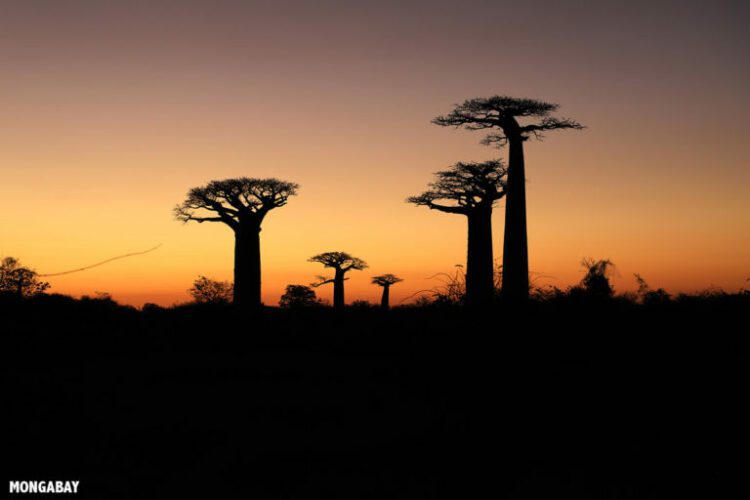Madagascar has a documented 2,900 endemic species of trees, but a new report shows that almost two-thirds of them are in danger of disappearing.Of the 3,118 species covered, more than 90% had never been systematically evaluated before, and one in 10 fell in the IUCN’s critically endangered category, a step away from going extinct in the wild.Though the island nation’s protected area network has expanded to more than 7 million hectares (17 million acres), a tenth of the tree species are found outside this safety net.Scientists are racing against the extinction clock to document this mind-boggling biodiversity and determine just how imperiled individual species are.
Aina Randriarisoa found a perch for Labramia ambondrombeensis on the taxonomical tree of life. She helped identify the tree from its genetic signature, the arrangement of its leaves, the shape of its flowers. Yet Randriarisoa, a 28-year-old Malagasy botanist, has never set eyes on the tree, and she fears she never will.
A 400-hectare (988-acre) forest fragment in northeast Madagascar, slightly bigger than Central Park, is the tree’s only known habitat, and it is shrinking. In Madagascar, a bottle-gourd-shaped island off Africa’s eastern coast, it is easy to miss the trees for the woods. Its fabled forests are retreating rapidly; 1-2% are wiped out each year.
Millions of years of isolation have given birth to a breathtaking variety of life-forms on the island, including 2,900 endemic tree species. Today, only a few thousand years since humans appeared here, two-thirds of these unique tree species are at risk of disappearing.
Scientists are racing against the extinction clock to document this mind-boggling biodiversity and determine just how imperiled individual species are. The effort sprinted forward this year with the completion of more than 2,400 assessments by a team of Malagasy and foreign researchers.
It was spearheaded by the Missouri Botanical Garden (MBG), Kew Madagascar Conservation Centre, the University of Antananarivo, and the IUCN. It is part of Botanic Gardens Conservation International’s Global Tree Assessment initiative. Madagascar is a top priority; it has 5% of the world’s tree species, high endemicity, but also one of the highest deforestation rates.
Of the 3,118 species covered in a recent report, more than 90% had never been systematically evaluated before. One in 10 of these trees falls in the IUCN’s critically endangered category, a step away from extinction in the wild. It’s analogous to Madagascar’s iconic lemurs; almost all of the 108 lemur species are threatened.
The incredible array of fauna the country has to offer often overshadows its vegetal diversity. Some experts estimate that only about half of Madagascar’s tree diversity is known to us.
Even when it does attract attention, the focus tends to be on high-value species like rosewood, palisander and ebony. Madagascar is rich in precious wood, home to more than a third of Dalbergia (including rosewood) and Diospyros (ebony) species. The illicit export of their timber has decimated large swaths of Malagasy forests. Randriarisoa and colleague Laurent Gautier from the Conservatory and Botanical Garden of the City of Geneva hope to save the Sapotaceae, a family of 90 species of hardwoods, including L. ambondrombeensis, from a similar fate.
These towering trees are in high demand locally, if not in the international market. Gautier described them as “old aristocrats.” They are well-adapted to their environs and do not take kindly to change. They grow and reproduce slowly, reaching sexual maturity in about 20 years. A Sapotaceae tree is confirmation that the forest has stood the test of time. “They are a symbol of a healthy forest,” Randriarisoa said.
But such undisturbed old-growth forests are dwindling. Slash-and-burn cultivation has eaten into woodland, and uncontrolled fires sear through forested areas every year. Even within the vestiges that remain, people single out these massive trees for logging.
L. ambondrombeensis is found in a coast-hugging evergreen littoral forest, which grows on sandy soils. It sits next to the Makirovana-Tsihomanaomby protected area, a block of moist, humid forests further inland in the Sava region of Madagascar. These rainforests lining the island’s eastern escarpment are bursting at the seams with endemic plant life.
Source link : https://news.mongabay.com/2021/05/madagascars-vanishing-trees/
Author :
Publish date : 2021-05-21 07:00:00
Copyright for syndicated content belongs to the linked Source.
